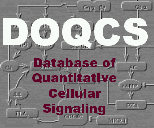
|
Enter a Search String | | Special character and space not allowed in the query term.
Search string should be at least 2 characters long. |
Molecule Parameter List for TnWA | The statistics table lists the distribution of a molecule acting either as a substrate, product, enzyme or as a molecule within the network.
The text color of a molecule is highlighted by  color. color. | | Statistics |
Accession and Pathway Details | |
| Accession Name | Accession No. | Accession Type | Pathway Link | | Chemotaxis | 57 | Pathway |
Chemotaxis | Reactions feeding into TnWa, TaWA and TWA are scaled by 10 Binding reaction of Tar with Aspartate has been scaled by 10 Phosphotransfer from CheAp to CheY has Kb = 0.263/sec/uM instead of 0.2/sec/uM used in BCT1.1.
All remaining parameters are from the .BCT files for BCT1.1 provided by Matthew Levin from the Computational Biology Group in the Department of Zoology at the University of Cambridge.
The June 2003 version of the BCT program is BCT4.3 and is available at the computational biology site of the Zoology department at Cambridge University.
Citation: Bray et al. Mol.Biol.Cell (1993) 4(5): 469-482. |
TnWA acting as a Molecule in Chemotaxis Network
| Name | Accession Name | Pathway Name | Initial Conc.
(uM) | Volume
(fL) | Buffered | | TnWA | Chemotaxis
Accession No. : 57 | Chemotaxis
Pathway No. : 228 | 0 | 1.41 | No | | Tar-Ni-CheW-CheA complex TnWA = 0 M As per Signal 15 in 1SIG.BCT provided by Matthew Levin Cell volume = 1.41e-15 L Table 1 pp.474 Bray et al 1993, Mol.Biol.Cell 4: 469-482 |
TnWA acting as a Substrate in a reaction in Chemotaxis Network
| Kd is calculated only for second order reactions, like nA+nB <->nC or nA<->nC+nD, where n is number and A,B,C,D are molecules, where as for first order reactions Keq is calculated.
Kd for higher order reaction are not consider. |
| Name | Accession Name | Pathway Name | Kf | Kb | Kd | tau | Reagents | Autophosphorylat
ion[3] | Chemotaxis
Accession No. : 57 | Chemotaxis
Pathway No. : 228 | 1
(uM^-1 s^-1) | 0
(s^-1) | - | - | Substrate
CheA
TnWA
Product
CheAp
| | TnWA stimulated autophosphorylation of CheA TnWA is complex of Tar, CheW, CheA and Ni Kf = 1*10e+06 /sec/M = 1 /sec/uM Kb = 0 /sec As per Reaction 10 in 1REACT.BCT provided by Matthew Levin Bray et al 1993, Mol.Biol.Cell 4: 469-482 Table 2 pp.475, Reaction scheme 3 |
TnWA acting as a Product in a reaction in Chemotaxis Network
| Kd is calculated only for second order reactions, like nA+nB <->nC or nA<->nC+nD, where n is number and A,B,C,D are molecules, where as for first order reactions Keq is calculated.
Kd for higher order reaction are not consider. |
| | Name | Accession Name | Pathway Name | Kf | Kb | Kd | tau | Reagents | | 1 | Complexing[8] | Chemotaxis
Accession No. : 57 | Chemotaxis
Pathway No. : 228 | 4
(uM^-1 s^-1) | 10
(s^-1) | Kd(bf) = 2.5(uM) | - | Substrate
CheW
TnA
Product
TnWA
| | | TnA and CheW complex formation Kf = 4*10e+05 /sec/M = 0.4 /sec/uM Kb = 1 /sec Bray et al 1993, Mol.Biol.Cell 4: 469-482 Table 3 pp.476 Reaction Scheme 7 Rates used here are 10 times that stated, to allow for faster time courses seen during the drop of bias on removal of stimulus. Footnote states that ligands do not have any effect on the formation of Tar-CheW-CheA complex so same rates are used for Aspartate or Ni associated Tar complexes. | | 2 | Binding[5] | Chemotaxis
Accession No. : 57 | Chemotaxis
Pathway No. : 228 | 4
(uM^-1 s^-1) | 10
(s^-1) | Kd(bf) = 2.5(uM) | - | Substrate
CheA
TnW
Product
TnWA
| | | Binding of TnW and CheA Kf = 4*10e+05 /sec/M = 0.4 /sec/uM Kb = 1 /sec Bray et al 1993, Mol.Biol.Cell 4: 469-482 Table 3 pp.476 Reaction Scheme 6 Footnote states that ligands do not have any effect on the formation of complexes so same rates are used for Aspartate or Ni associated tar complexes. | | 3 | Binding[10] | Chemotaxis
Accession No. : 57 | Chemotaxis
Pathway No. : 228 | 4
(uM^-1 s^-1) | 10
(s^-1) | Kd(bf) = 2.5(uM) | - | Substrate
Tn
WA
Product
TnWA
| | | Binding of Tn and CheW-CheA complex Kf = 4e+05 /sec/M = 0.4 /sec/uM Kb = 1 /sec Bray et al 1993, Mol.Biol.Cell 4: 469-482 Table 3 pp.476 Reaction Scheme 8 Rates used here are 10 times that stated, to allow for faster time courses seen during the drop of bias on removal of stimulus. Footnote states that ligands do not have any effect on the formation of complexes so same rates are used for Aspartate or Ni associated Tar complexes. |
| Database compilation and code copyright (C) 2022, Upinder S. Bhalla and NCBS/TIFR
This Copyright is applied to ensure that the contents of this database remain freely available. Please see FAQ for details. |
|
